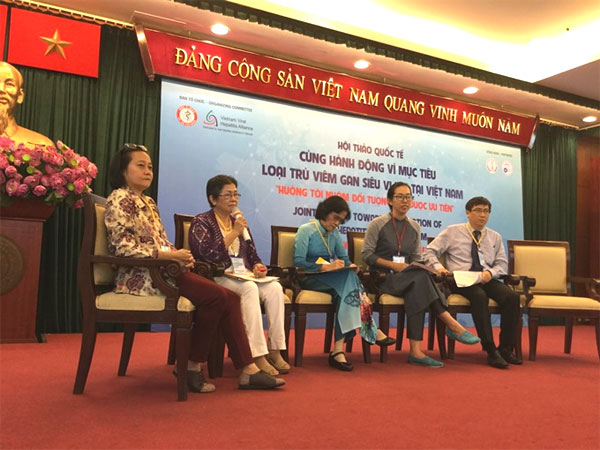VietNamNet Bridge – Setting targets for prevention, diagnosis and treatment, and monitoring this progress are imperative as the number of hepatitis patients in Viet Nam who receive treatment is too low, according to experts.

The two-day conference highlights joint actions towards the elimination of viral hepatitis B and C in Viet Nam with a focus on priority populations held in HCM City on July 29 and 30. — Photo: VNS
“Accessing diagnosis and treatment is a challenge”, said Dr. Nguyen Thu Anh of General Department of Preventive Medicine at a two-day conference on joint actions towards the elimination of viral hepatitis B and C in Viet Nam that started on July 29 in HCM City.
It is estimated that 3.22 million patients this year are living with the hepatitis B virus and are eligible for treatment given they have cirrhosis of the liver or a high viral load.
However, only 43,230 diagnosed cases are receiving treatment.
According to the department’s forecast, fatalities relating to liver diseases will trend up from 30,000 in 2015 to 45,000 in 2030 if there is no intervention.
This year, it is estimated 967,000 patients will be diagnosed with the hepatitis C virus and only 74,000 of them will receive treatment.
Dr. Kato Masaya of the World Health Organisation Viet Nam suggested that Viet Nam should set targets for “treatment scale-up” and a mechanism to monitor the progress.
“Scale-up of HCV treatment will substantially reduce chronic infection, hepatocellular carcinoma and liver-related deaths,” Masaya said.
“Upfront investment will lead to cost-saving in the future,” he added.
Anh said that the department did policy research to enhance tests and treatment of hepatitis B and C virus infection.
Other representatives said that global and regional targets and milestones would help to set national goals for a coordinated approach for the elimination of hepatitis.
Defining key interventions from pregnancy to the postnatal period for the mother, partner and child should be strengthened, they said.
Viet Nam also should build a strong hepatitis B vaccination programme, they said, adding that the rate of infants in Viet Nam getting the vaccine in this year’s first five months was 26.9 per cent.
Many women did not get vaccines before marriage and pregnancy, they added.
An incremental approach to antenatal screening, the potential use of maternal antiviral and hepatitis B immunoglobulin for exposed infants were very important, they said.
According to experts, Viet Nam has many opportunities for policies and guidelines on testing, treatment and prevention of hepatitis.
However, a shortage of resources and funds for implementation, screening and prevention is a challenge, while there is limited coordination.
Dr. To Ngoc Nga of HCM City University of Medicine and Pharmacy said: “Prevention for hepatitis is not difficult.”
Vaccination is considered an effective prevention, Nga said, and added that an education programme on the importance of vaccines should be carried out. Women aged 15 to 49 should be targeted for the education.
“Viet Nam is among the countries that suffer the most from viral hepatitis B and C, with a disease prevalence of 10 to 20 per cent of the total population,” Dr. Truong Thi Xuan Lieu, chairwoman of HCM City Medical Association, said.
Moreover, liver cancer was ranked third among all cancers, she said, adding that all resources from the health sectors as well as the community should be called on to deal with this alarming situation.
The conference was organised by the HCM City Medical Association in co-operation with the Viet Nam Viral Hepatitis Alliance, Viet Nam Cancer Association and HCM City Association for Study of Liver Diseases.
VNS